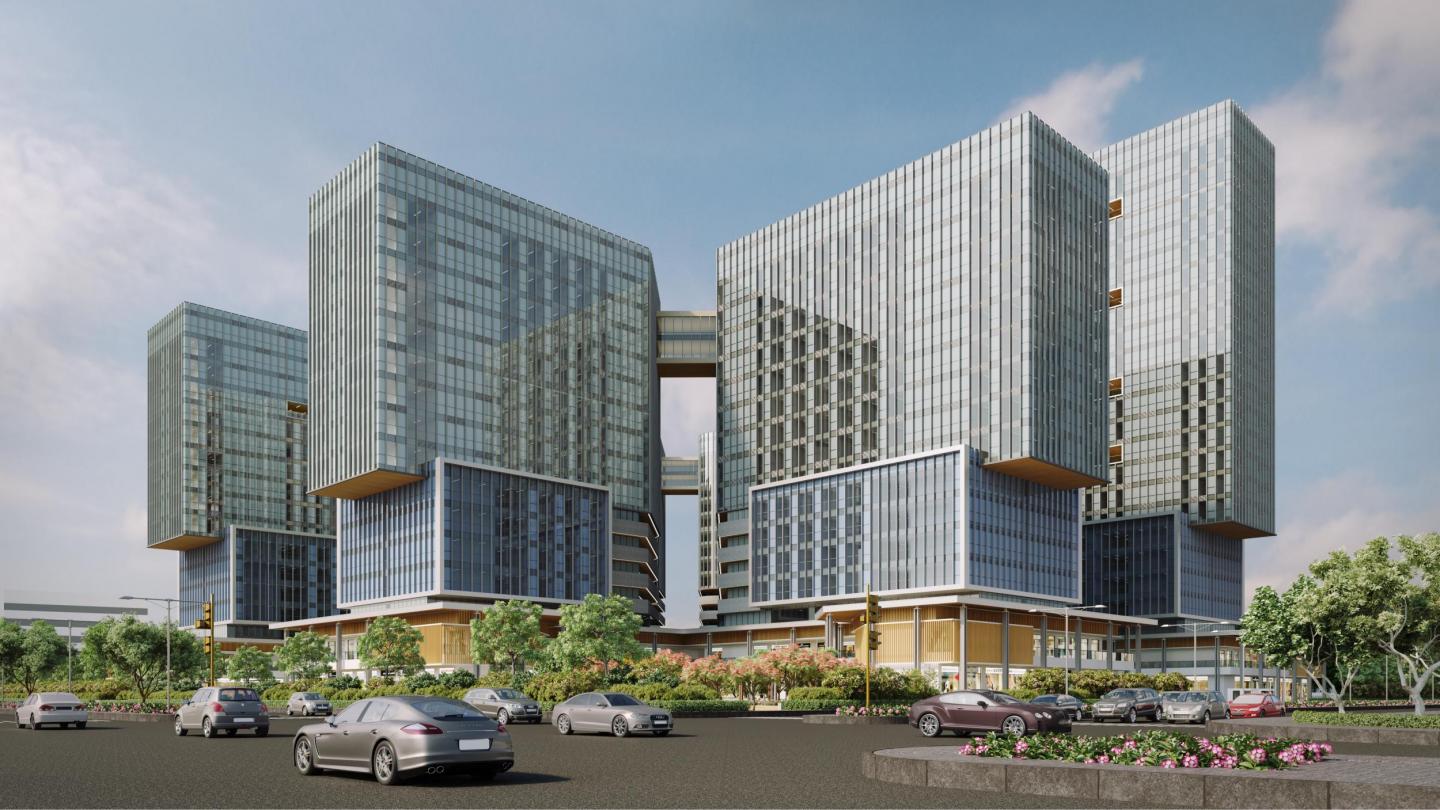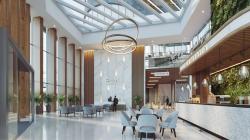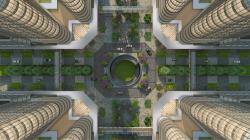The Eye of Noida (EON) is a mixed-use development project that is designed using an approach of intelligent urbanism helping to foster sociability and sustainability.Placed along the crossing of two 45 metre wide roads, the site encompasses IT office spaces, retail spaces, food plazas and recreational spots intertwined with transitional courtyards.The design strategy follows a phase-wise development, to divide the plot into four distinctly identifiable sectors. Each of the four sectors has its own office spaces, retail areas and a landscaped plaza.45 metres wide, arterial boulevards induce an ease in traffic circulation, with vehicular traffic directed to the basement areas The pedestrian boulevard also offers break-out spaces for the central dining and retail zones to advocate gatherings. A dramatic staircase attracts pedestrians to encourage walking to the basement. Designed in a grid layout, the urban matrix is a collaboration of eco-friendly infrastructure, lively alfresco settings and an iconic landscape design.
The Eye of Noida (EON) is a mixed-use development project conceptualised by Design Forum International for the Fairfox ITinfra Private Limited. Located in Noida Sector 140A, the project is designed using an approach of intelligent urbanism to help foster sociability and sustainability. While furnishing a sensorial spatial experience in a multipurpose footprint, the development sets a new benchmark in workplace design.
Placed along the crossing of two 45 metre wide roads, the site encompasses IT office spaces, retail spaces, food plazas and recreational spots intertwined with transitional courtyards. These different spaces come together to create a promenade that is situated amidst a modern concrete jungle. The project employs key features to replace the traditional glass box in order to create a landscaped street while offering flexible and adaptive spaces.
The design strategy follows a phase-wise development, where two boulevards intersect perpendicularly to divide the plot into four distinctly identifiable sectors. Each of the four sectors has its own office spaces, retail areas and a landscaped plaza. Both the arterial boulevards cutting across the site are 45 metres wide. They induce ease in traffic circulation, as one directs vehicular traffic to the basement parking areas, and the other is exclusively designed for pedestrian circulation. The pedestrian boulevard also offers break-out spaces for the central dining and retail zones, intended for receiving the footfall overflow from these areas and to advocate gatherings. The basement is connected to the ground level by a dramatic staircase designed to encourage walking. The project aspires to reconcile nature and the culture of the community by offering scale-friendly and pedestrian-oriented premises. Designed in a grid layout, the urban matrix is a collaboration of eco-friendly infrastructure, lively alfresco settings and an iconic landscape design. The kerb-less driveway experience is enhanced using accent sculptures and feature walls interacting with a dense forest plantation.
2021
The landscape is planned in an attempt to integrate the indoors with the outdoors, to partake in a sensorial spatial experience and simultaneously weave sustainability patterns within a dense urban conglomeration. The impetus of research focuses on reducing the urban heat island effect by using specific moderate-to-dense textured trees with widespread canopies and a design scheme entailing an increase in the number of storeys and shading devices, green walls and roofs, and relatively cooler pavements. The courtyards are designed as multipurpose, configurable spaces housing food kiosks around dining decks, outdoor lounges, coffee shops and amphitheatres. Abundant seating areas are incorporated throughout the open plazas under shading structures. The pavilions laid out in all four segments are thoughtfully equipped with electrical points and external Wi-Fi support to create invigorating workspaces. Maximised opportunities for interaction aid in better work environments that help maximise productivity.
A key feature is connectivity between the four segments, not only at the grade level but also using elevated skywalks that connect the built forms. Each of the four parts of the project has its own distinct character, with an interplay of food, congregation and recreation that induce a campus-like ambience. The interstitial spaces identified by the two boulevards become spaces of experience — much more than their inherent function of circulation. While embedding opportunities for public as well as intimate interaction throughout the space, the project establishes a comfortable urban environment that moves away from the banal.
CONSULTANTS
Structural: NNC design international
Mechanical: Multiple service consultant
Electrical: Multiple service consultant
Landscape: Integral designs
HVAC: Multiple service consultant
Plumbing: Multiple service consultant
Façade: Axis Facade Consulting Private Limited










